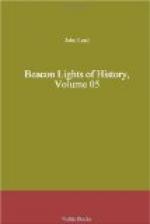AUTHORITIES.
Fergusson’s History of Architecture; Durand’s
Parallels; Eastlake’s
Gothic and Revival; Ruskin, Daly, and Penrose; Britton’s
Cathedrals and
Architectural Antiquities; Pugin’s Specimens
and Examples of Gothic
Architecture; Rickman’s Styles of Gothic Architecture;
Street’s Gothic
Architecture in Spain; Encyclopaedia Britannica (article
Architecture).
JOHN WYCLIF.
* * * * *
A.D. 1324-1384.
DAWN OF THE REFORMATION.
The name of Wyclif suggests the dawn of the Protestant Reformation; and the Reformation suggests the existence of evils which made it a necessity. I do not look upon the Reformation, in its earlier stages, as a theological movement. In fact, the Catholic and Protestant theology, as expounded and systematized by great authorities, does not materially differ from that of the Fathers of the Church. The doctrines of Augustine were accepted equally by Thomas Aquinas and John Calvin. What is called systematic divinity, as taught in our theological seminaries, is a series of deductions from the writings of Paul and other apostles, elaborately and logically drawn by Athanasius, Jerome, Augustine, and other lights of the early Church, which were defended in the Middle Ages with amazing skill and dialectical acuteness by the Scholastic doctors, with the aid of the method which Aristotle, the greatest logician of antiquity, bequeathed to philosophy. Neither Luther nor Calvin departed essentially from these great deductions on such vital subjects as the existence and attributes of God, the Trinity, sin and its penalty, redemption, grace, and predestination. The creeds of modern Protestant churches are in harmony with the writings of both the Fathers and the Scholastic doctors on the fundamental principles of Christianity.




